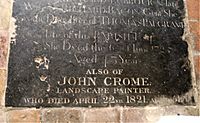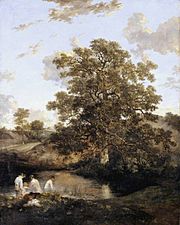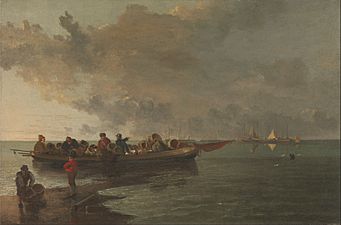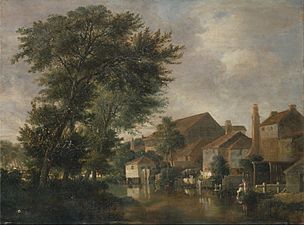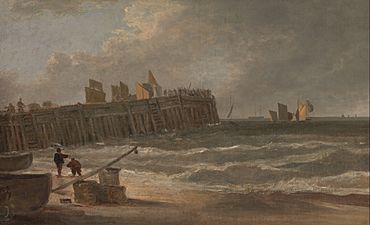John Crome facts for kids
Quick facts for kids
John Crome
|
|
|---|---|
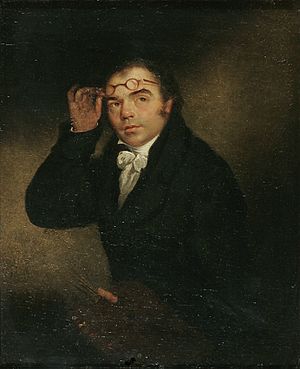
Portrait by Michael William Sharp
|
|
| Born |
John Crome
22 December 1768 Norwich, England
|
| Died | 22 April 1821 (aged 52) Norwich
|
| Nationality | English |
| Movement | Norwich School of painters |
| Spouse(s) | Phoebe Berney |
John Crome (born December 22, 1768 – died April 22, 1821) was an English landscape painter. People sometimes called him "Old Crome" to tell him apart from his artist son, John Berney Crome. He was a key artist and a founder of the Norwich School of painters.
John Crome lived his whole life in Norwich, England. Most of his paintings show the beautiful landscapes of Norfolk. His art can be seen in famous galleries like the Tate Gallery and the Royal Academy in London. You can also find his work at the Castle Museum in Norwich. Besides painting, he also made etchings and taught art to others.
Contents
John Crome's Life Story
Early Life and Learning Art
John Crome was born in Norwich on December 22, 1768. He was baptized a few days later at St George's Church, Tombland, Norwich. His father, also named John Crome, was a weaver.
When he was 12, John Crome worked as an errand boy for a doctor. Later, he became an apprentice to Francis Whisler, who painted houses, coaches, and signs. Around this time, he became friends with Robert Ladbrooke, who was learning to be a printer. They often went on trips to sketch the fields and lanes around Norwich. They also bought prints to copy and learn from.
Becoming an Artist and Teacher
Crome and Ladbrooke sold some of their artwork to a local print shop. This led Crome to meet Thomas Harvey, who helped him start teaching drawing. Crome could also study Harvey's art collection. This helped him improve his skills by copying works by famous artists like Thomas Gainsborough and Meindert Hobbema.
Artists John Opie and William Beechey also encouraged Crome. He often visited Beechey's house in London to learn more.
In October 1792, John Crome married Phoebe Berney. They had eight children. Two of their sons, John Berney Crome and William Henry Crome, also became landscape painters.
Founding the Norwich School of Artists
In 1803, Crome and Ladbrooke started the Norwich Society of Artists. This group included other artists like Robert Dixon and James Stark. Their first art show was in 1805. This event marked the beginning of the Norwich School of painters. It was the first art movement in England to be created outside of London.
Crome showed 22 of his works at that first exhibition. He was the President of the Society many times, including when he passed away. He mostly stayed in Norwich, only making short trips to London. He showed 13 of his paintings at the Royal Academy between 1806 and 1818.
In 1814, after Napoleon was defeated, Crome visited Paris. He later showed paintings of Paris, Boulogne, and Ostend. However, most of his paintings were of scenes in his home county of Norfolk.
Teaching Art to Others
John Crome taught drawing at Norwich School for many years. Several artists from the Norwich School art movement were his students there. He also gave private lessons. Some of his students were from the important Gurney family. He stayed with them when he visited the Lake District in 1802.
Later Life and Legacy
John Crome died at his home in Norwich on April 22, 1821. He was buried in St. George's Church. It is said that on his deathbed, he whispered, "Oh Hobbema, my dear Hobbema, how I have loved you." This shows how much he admired the Dutch painter Meindert Hobbema.
In November of that year, the Norwich Society of Artists held a special show. It featured over 100 of Crome's paintings to honor him.
Today, places like Crome's Broad and Crome's Farm in The Broads National Park are named after him. There's also a part of Norwich called the Crome ward, named in his honor.
John Crome's Artworks
John Crome, sometimes called "Old Crome," used both watercolour and oil for his art. He created more than 300 oil paintings during his career.
Etchings and Influences
Between 1809 and 1813, he made a series of etchings. These are prints made by scratching a design onto a metal plate. He planned to publish them, but they were not released during his lifetime.
Crome's art was mainly influenced by two things. One was Dutch 17th-century painting. The other was the work of the Welsh landscape painter Richard Wilson.
Painting Nature and Everyday Life
Along with artist John Constable, Crome was one of the first English painters to show specific types of trees in his art. Before them, artists often painted more general tree shapes. Crome's works are known for being original and full of vision. He studied old master paintings and also observed the natural world very closely.
Art historian Andrew Hemingway noted that Crome's paintings often show people enjoying their free time. For example, he painted scenes of the beach at Great Yarmouth. He also painted the River Wensum in Norwich. One example is his oil painting Boys Bathing on the River Wensum, Norwich, from 1817. It shows a scene at New Mills, a place he painted many times.
Gallery
-
The Poringland Oak (about 1818), National Gallery
-
A Barge with a Wounded Soldier (date unknown), Yale Center for British Art


